Here in the Andes, every year travellers just like you wonder about the different things to do at Machu Picchu and how to witness the mystical essence of the most popular citadel in South America.
One of the things you will discover is that ancient Machu Picchu still provides the setting for the economic and cultural revival of the Incas’ descendants. So, before wondering about what to do in Machu Picchu, take a moment just to think about the construction of the site and try to imagine how such an archeological complex played an important role in Andean culture, then get ready to be enchanted by its magical, mystical, and religious character.
Read on to find some valuable information to enjoy the most of the tour during your Peru travel experience.

How to Visit Machu Picchu
Visiting Machu Picchu is a once-in-a-lifetime experience, the fulfillment of a childhood dream for many! But these days, it’s highly regulated by the government, with a lot of rules about when and how you can tour the ruins. (For more details on planning your trip to Machu Picchu, check out our complete Machu Picchu travel guide).
Four Ways to Visit Machu Picchu
If you want to experience the greatness of the famous Inca citadel, you have to choose one of the four types of entrance tickets* that are available:
- Machu Picchu Ruins only: Tour the ruins for a maximum of 2 hours and 30 minutes
- Machu Picchu Ruins + Huayna Picchu Mountain: Climb Huayna Picchu and tour the ruins, in a maximum of 3 hours.
- Upper Terrace + Machu Picchu Mountain: Hike Machu Picchu Mountain and tour the Upper Terraces (no access to the ruins). Maximum of 4 hours.
- Machu Picchu Ruins + Huchuy Picchu Mountain: Hike the Huchuy Picchu Trail and tour the ruins in a maximum of 3 hours and 30 minutes at the site.
Don’t know what ticket to choose? In this post, we cover detailed information to help you decide which ticket is the best. Just bear in mind that the kind of experience you will have depends on the type of ticket you purchase.
*Recently, there have been occasional, temporary closures of some of the routes. We advise you to check the official website or contact us for the latest information.
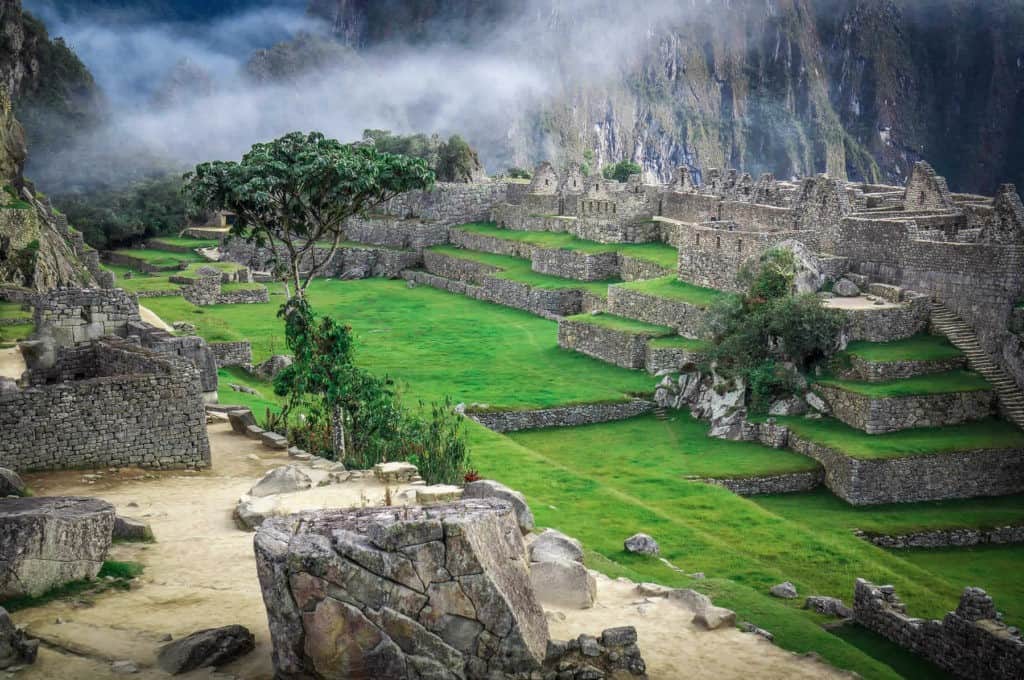
The 3 Circuits for Touring the Ruins – Overview
Years ago, Machu Picchu was essentially open, and you were free to explore the ruins with your guide in whatever order you liked, or just take time out to stare across the canyon into the surrounding mountains.
This is not the case anymore.
Starting in June 2024, there are now three defined circuits that visitors must follow.
You might recall that this system of defined circuits started back in 2021, when the first set of circuits were introduced. These have just been modified – which we’ll explain in detail below.
Every Machu Picchu entrance ticket is tied to a specific circuit, and you must follow the circuit as it appears on your ticket. These defined paths take you through different sectors of the site, stopping at different attractions, so it’s important to choose the circuit that most suits your interests. As they are circuits, all routes start at the entrance and end at the exit, and once you reach the end, you must exit the site. Unless you have an additional ticket, you cannot re-enter the site once you exit.
In addition to modifying the circuits you can follow when visiting Machu Picchu, the Ministry of Culture has also increased the site’s total visitor capacity, from around 4500 visitors per day to now 5600 visitors per day at Machu Picchu, during high season. But, of those 5600 visitors, only around 3000 will actually visit the main part of the ruins.
Here is everything you need to know about the Machu Picchu circuits in 2024:
Circuit 1 (Panoramic; 1100 tickets per day)
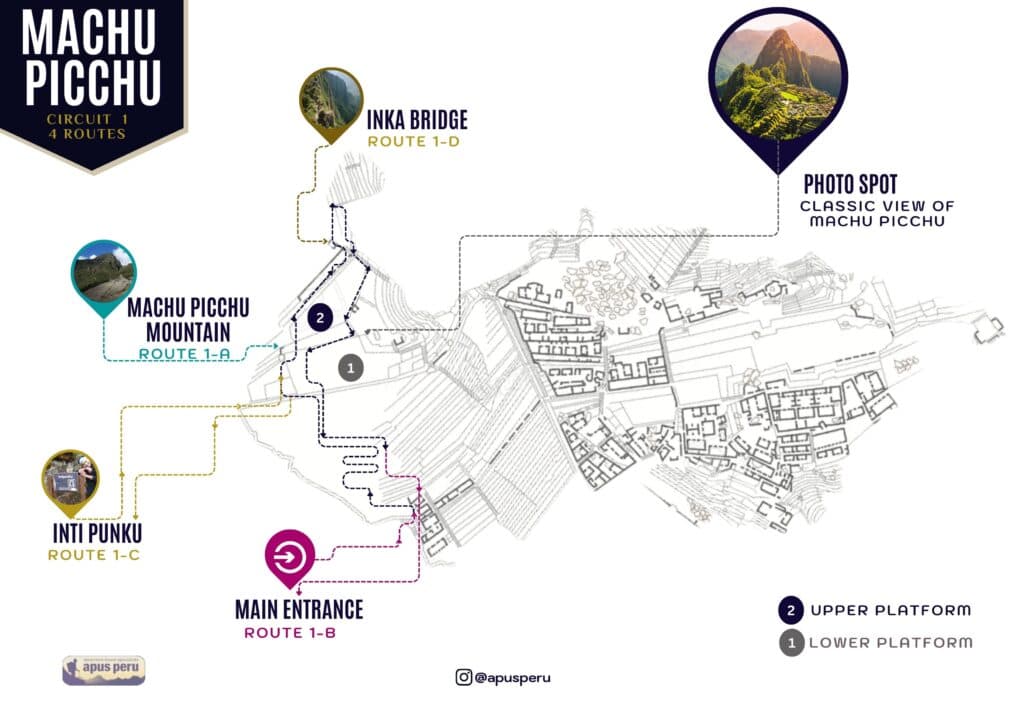
Circuit 1 covers the upper part of site. It includes the prime location for taking those classic Machu Picchu photos, but does not include access to any part of the ruins themselves.
It is split into 4 routes:
- Route 1-A: Machu Picchu Mountain
- Route 1-B: Upper Terrace
- Route 1-C: Inti Punku (Sun Gate)
- Route 1-D : Inka Bridge
Circuit 2 (Classic Machu Picchu; 3050 tickets per day)
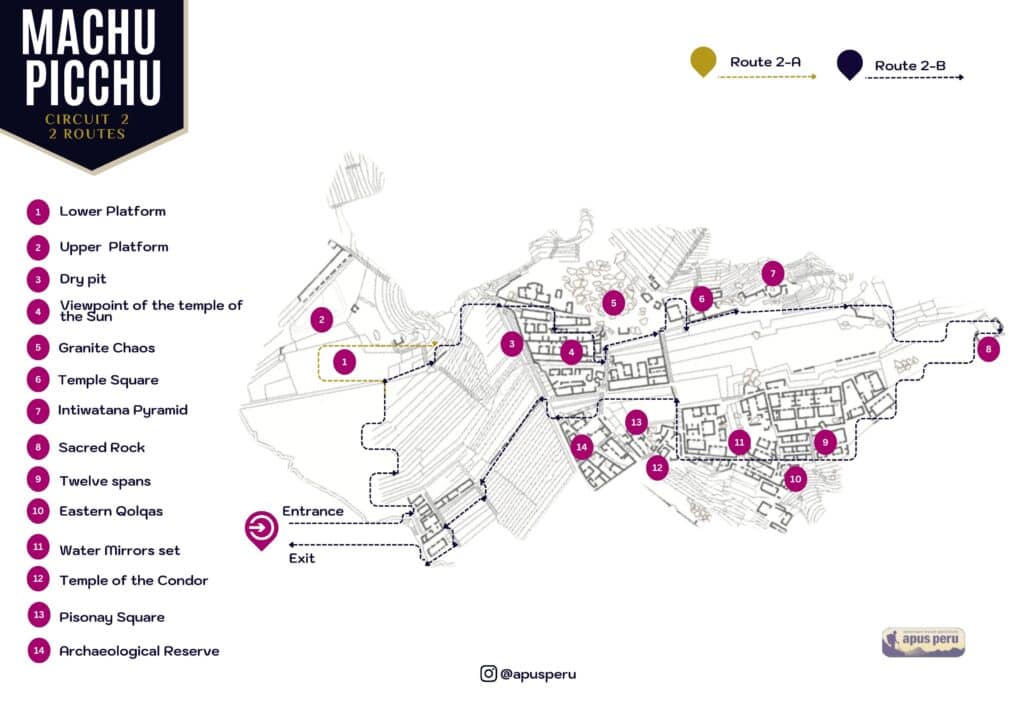
Just like before, Circuit 2 is considered the most “complete” circuit, and allows access to both the upper and lower parts of the Machu Picchu ruins.
This circuit is split into just two routes:
- Route 2-A: Designed Route
- Route 2-B: Lower Terrace
They are almost identical, except that the Lower Terrace route also includes a stop at one of the Upper Terraces for those classic pictures of the city with Huayna Picchu mountain looming behind.
Some of the temples and other highlights included on this circuit include:
- Dry Pit, Tectonic Fault
- Viewpoint of the Temple of the Sun
- Granite Chaos
- Square of the Temples
- Intihuatana Pyramid (view from above)
- Sacred Rock
- Twelve Opening
- Eastern Deposits
- Water Mirror Set
- Temple of the Condor
- Pisonay Square
- Archaeological Reserve
Maximum time permitted on this ticket: 2 hours and 30 minutes.
As one of the most popular circuits, you can expect tickets for Circuit 2 to sell out very fast, despite being the most numerous.
Circuit 3 (Royal Circuit; 1450 tickets per day)
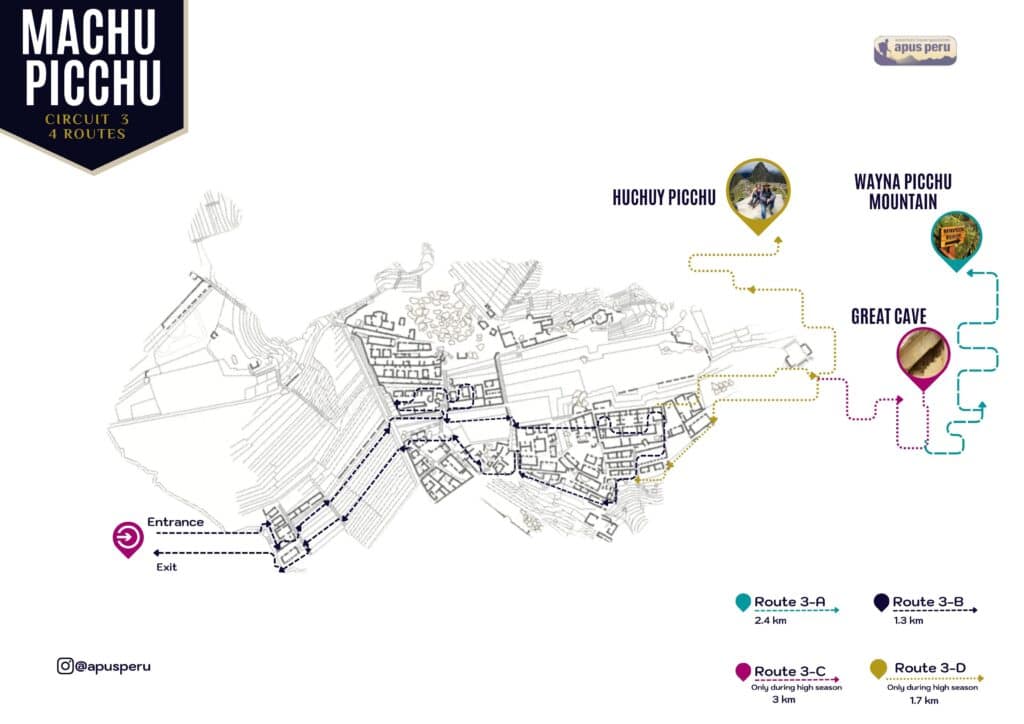
As tickets for Circuit 2 routes are likely to sell out first, anyone who books late – less than a month prior to their arrival – is likely to have to choose Circuit 3.
But that’s not a bad thing! Actually, while Circuit 2 is considered the “most complete,” it doesn’t actually include everything; there are some features of Machu Picchu that you can only see if you do Circuit 3 – like the Royal zone and the Temple of the Sun, considered the most important temple at Machu Picchu.
The Circuit 3 routes don’t include access to the upper terraces, meaning you won’t get that same almost bird’s-eye shot over the ruins that everyone craves, but you can get pretty close and still take a gorgeous photo of the ruins.
In fact, those who choose Circuit 3 will get to retrace the very footsteps of Hiram Bingham – the famous American explorer credited with rediscovering Machu Picchu in 1911 – for he stood on that very same spot to take the first-ever photograph of Machu Picchu.
Bonus: this spot is also wheelchair accessible, making Circuit 3 a good option for those with limited mobility. As it’s shorter than Circuit 2, it’s also another good option for families who want to limit their time touring ruins.
Just like Circuit 1, Circuit 3 is also divided into 4 routes. Each route follows the same path around the lower terraces, and includes the following highlights:
- Temple of the Sun
- Inca House Set
- Sacred Rock
- Twelve Opening
- Eastern Deposits
- Water Mirror Set
- Temple of the Condor
- Pisonay Square
- Archaeological Reserve
In addition, three of the routes include hikes to special attraction to add some extra adventure to your Machu Picchu visit.
More About The 3 Circuits & Their 10 Sub-Routes
Route 1-A: Machu Picchu Mountain
If you are interested in hiking Machu Picchu Mountain, this is the circuit for you. Machu Picchu Mountain is a great hike if you’re craving a little extra adventure. This 3-hour round trip hike is not overly strenuous or vertigo-inducing, and gives you amazing views of Huayna Picchu mountain – the mountain visible in every classic shot of Machu Picchu – as well as the ruins below.
This route no longer permits a re-entry into the ruins itself; for that, you will need to purchase a separate ticket.
Route 1-B: Upper Terrace
As the name implies, this route gives you access to the upper terraces of Machu Picchu where you can get that classic shot of the city below. This is the shortest of all the circuits – it takes about 1.5 to 2 hours to complete – and doesn’t actually give you access to any of the major temples at all.
It is ideally suited to families with young children, people short on time or anyone else who doesn’t want to spend a lot of time walking around – those who care more about being able to say they made it to Machu Picchu, and sharing that achievement with others, rather than getting into the nitty-gritty of Inca history.
Route 1-C: Inti Punku (Inca Sun Gate)
*Note: This route is currently only available during the high season (June 1st to October 15th)
Like the Machu Picchu Mountain circuit, Route 1-C adds an extra bit of adventure to the Upper Terraces circuit. In addition to being able to tour the upper part of the site and get those classic shots, you also get to do what is otherwise reserved only for the lucky few who hike the Inca Trail into Machu Picchu: walk through the Sun Gate.
The Sun Gate – or Inti Punku, as it’s known in Quechua – is the gateway into Machu Picchu from the Inca Trail. From this point, visitors get to witness Machu Picchu basically emerge out of the mountain tops. It’s a magical experience, especially on misty mornings where the ruins drift in and out of view.
It’s about 55 minutes one way – an hour and a half round trip, if you’re speedy – but with this ticket, you can spend up to 4 hours inside citadel.
Route 1-D: Inca Bridge
*Note: This route is currently only available during the high season (June 1st to October 15th)
A lucky addition for anyone visiting Machu Picchu in 2024, the Inca Bridge has finally reopened to visitors, after a long pandemic-induced hiatus. This short hike is not for the faint-hearted but is certainly a thrilling addition to any Machu Picchu tour.
Just like the rest of Circuit 1, this route includes the Upper Terraces for those classic photos, but it does not grant entry into the ruins themselves. Total time allowed in the site with this ticket is 3 hours.
Route 3-A Huayna Picchu Mountain
Huayna Picchu is the other famous hike you can do, and probably the most well-known. It involves scaling the top of the mountain that serves as the backdrop in all those classic Machu Picchu photos.
The hike is not for the faint-hearted! It takes about an hour and a half round-trip, but it is very steep and there are sections where there are sheer drop-offs on either side; there’s even a part where you need to use cables to help pull yourself up the slope.
Not recommended during the rainy season, hiking Huayna Picchu can be a great challenge during dry season.
Route 3-B: Designed Route
The second route is the classic Circuit 3 tour of the lower terraces; it does not extend beyond this circuit to the entry points for any of the extra hikes, like Huayna Picchu.
Most tours of Route 3-B take about an hour and a half to two hours, but the ticket permits a stay of up to two and a half hours total.
Route 3-C: Great Cavern
*Note: This route is currently only available during the high season (June 1st to October 15th)
Previously known as the Temple of the Moon, la Gran Caverna is a great alternative hike for those looking to escape the crowds at Machu Picchu.
On the way to Huayna Picchu, there is a fork in the road; one path leads to Huayna Picchu, the other, to the Great Cavern.
If you follow this path – up and down some small, narrow stone steps – you eventually reach what looks a room with three windows, holding up the mighty mountain above. This is a location of great mystic and astronomical significance.
Round trip to the Gran Caverna and back – including your tour of the ruins – takes about 5-6 hours, but you can spend up to 7 hours at Machu Picchu on this ticket.
Route 3-D: Huchuy Picchu
*Note: This route is currently only available during the high season (June 1st to October 15th)
Huchuy Picchu – “small peak” – is a great alternative for those interested in the views that Huayna Picchu offers, but who aren’t willing to face that steep upwards climb.
The climb up Huchuy Picchu takes about 20 minutes (40 minutes round trip), making it a nice, fairly short hike up. It’s also less steep than Huayna Picchu, without the treacherous drop-offs, making this is a nice alternative for families with young children.
Maximum stay time: 3 hours and 30 minutes
Machu Picchu Tickets & Entrance Times
Whether you take the train or do a Machu Picchu trek, you will have to book ahead. Entry to Machu Picchu is highly controlled, and tickets have been known to sell out in advance for certain entry times. In particular, if you plan to book a hike with a Machu Picchu visit, only a small number of tickets are available each day:
- 50 for Huchuy Picchu
- 300 for Huayna Picchu, and,
- 200 for Machu Picchu Mountain.
If you know you want to do one of these hikes, you should tell us at the time of booking.
Since 2019, entry to Machu Picchu has been by the hour – meaning, you have to decide what time to enter Machu Picchu at the moment you purchase your ticket. The entry times for the standard Machu Picchu ruins tour are distributed in 9 intake periods, starting at 6am and ending at 2pm. The site closes at 5pm. Note: there is a 30-minute grace period for each hourly ticket; if you arrive after that time, you will be denied entry.
Entry times for tickets which include one of the Machu Picchu hikes vary. For instance, there are only 2 intake periods per day for Huayna Picchu and Machu Picchu Mountain.
Some independent travellers prefer to do the booking process by themselves, but doing this is a little bit risky due to timing: it can be tricky to coordinate your ticket entrance times with the time of the trains, and you also must enter with a guide.
If you want to avoid all that stress, we recommend booking though an agency. Our friendly and experienced staff is more than ready to assist you, so contact us to book your Machu Picchu experience.
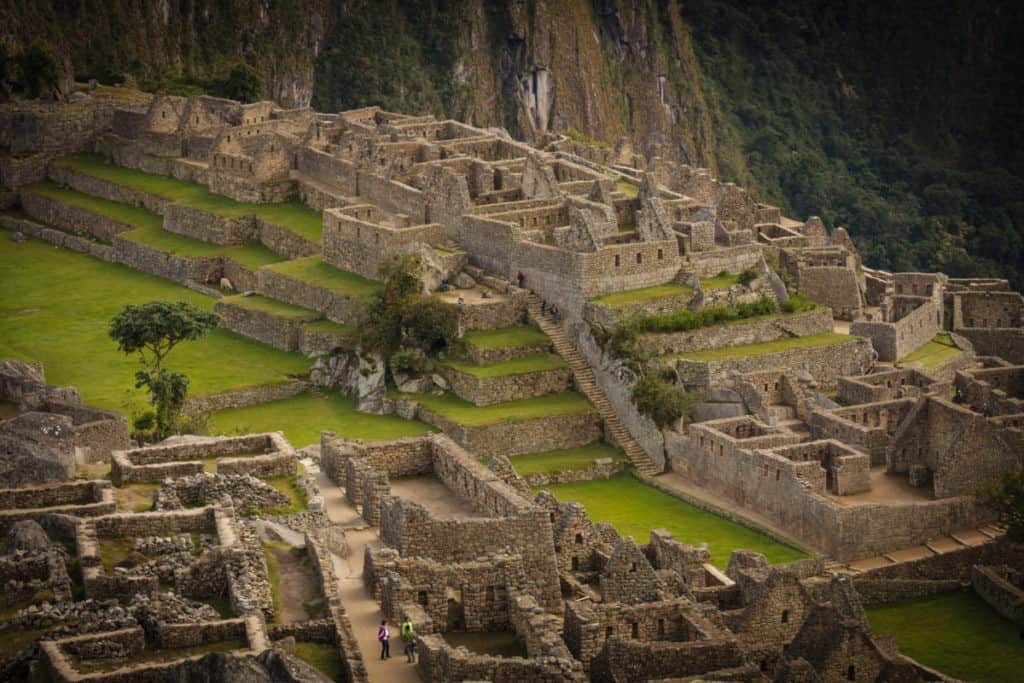
Schedule of Machu Picchu Attractions
Astute readers will have noticed entry times listed beside some of the attractions noted above. Here are those times again:
- Temple of the Condor: 10am to 1pm
- Temple of the Sun: 1pm to 4pm
- Intihuatana Pyramid: Permanently Closed
You can view Intihuatana from above on Circuit 2; the Temples of the Condor and of the Sun are only accessible via Circuit 3. The Ministry of Culture may also add additional visiting hours in due time.
Visiting the Incan Citadel: Things to do in Machu Picchu
In the Citadel of Machu Picchu, you will identify two main areas: the urban area which includes temples, monuments, funerary chambers and housing sub-areas, and the agricultural area which covers a variety of terraces. But wait, there are more things to see in Machu Picchu! You will observe a drain channel that lies between these two areas and apparently it was built to deal with the heavy rains of the Andean region.
Regarding the Machu Picchu attractions, is important to pay close attention to small details. In the centre of the ancient city, you will see a vast plaza. On the left of this plaza, find the solar observatory which you can access through a stairway that starts behind an open building having only three walls. If you head to the front of this building, you will find a small plaza better known as the main temple.
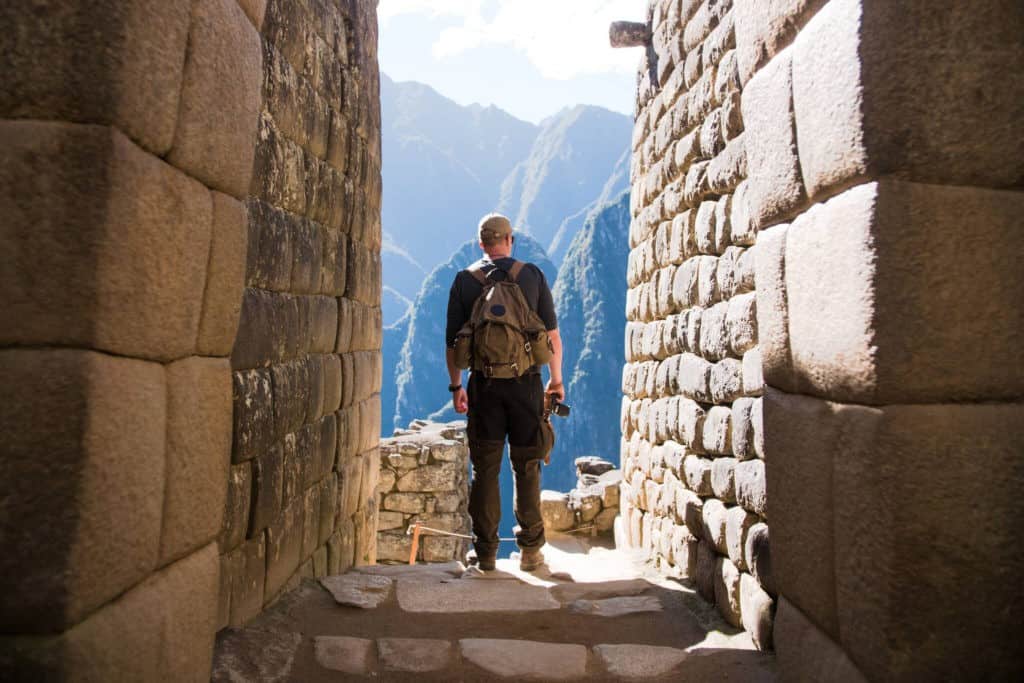
Here is an overview of what you can see at Machu Picchu, places to visit on your tour.
Discover the Intihuatana
What you are going to find here is one of those places to visit in Machu Picchu with a sacred story behind it. Two interesting aspects of Intihuatana to keep in mind: First, its location on the top of a ceremonial hill; and second, the carved stone that was used in the construction of the site, also served as an element for rites.
Explore the Temple of the Sun
This temple is a good photo opportunity because is the only circular building in Machu Picchu. But besides that, it is one of the spots with the most ritual meaning at the citadel.
Observe the landscape through the Temple of 3 Windows
What you can do at Machu Picchu is walk to the sacred plaza, and explore this temple, and admire the view through its three windows towards the Main Plaza.
Learn about the purpose of the terraces
There are so many things to do at Machu Picchu even learning about ancient architecture. When you walk the terraces you will notice two types of terraces: the agrarian one used for cultivation purposes, and a second one transformed as a retaining wall to prevent landslides.
The Sun Gate
This path made of steps is one of the most important archeological constructions that connects with the Inca citadel and all Machu Picchu activities. This building is dedicated to the cult of Inti, the sun god. Indeed, at different times of the year, the sun shines directly through this structure.
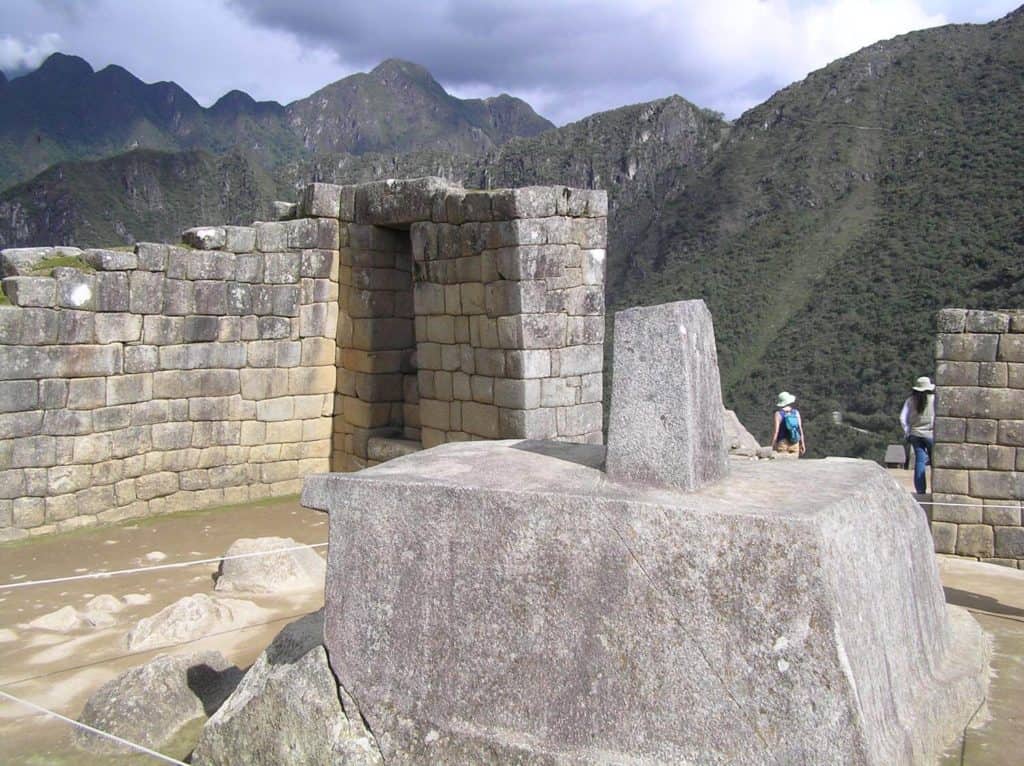
Watchman’s Hut
This site is part of the agricultural area where Incas used an elaborate drainage system for cultivating maize (corn, aka choclo. Read more about Peruvian corn here!)
Take a break in the Caretaker’s Hut
Close to the main entrance door, you can admire the only renovated building in the citadel. It has a roof, so if your tour is during the rainy season, this is the right spot to listen to the melody of the rain while you connect with a marvelous landscape.
Find the Funerary Stone
This sacred rock, easy to find in the upper agricultural area, represents the surrounding hills, but during the Inca Empire, it had a ritual role.
Temple of the Condor
At this temple, you will have the chance to appreciate how Incan architects used their ability to transform a natural formation into a place with a deep ritual meaning.
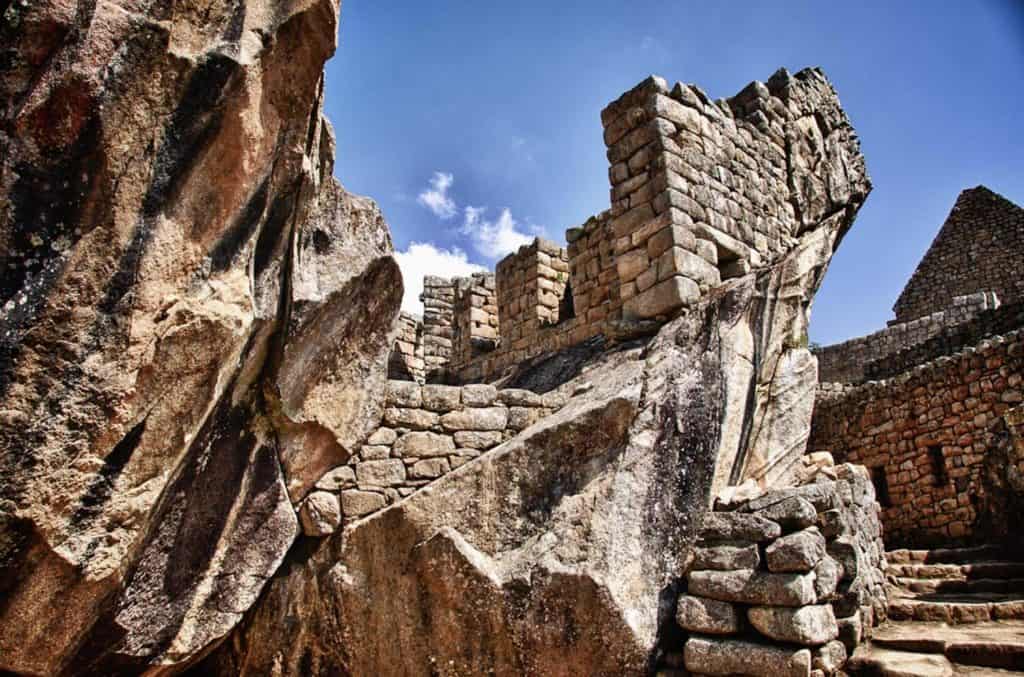
Pay a visit to the Royal Tomb
If you wonder what is there to do in Machu Picchu, we recommend not to miss the opportunity to visit the Royal Tomb. There is a kind of mystery related to this site, not just because of its location (under the Temple of the Sun) but also because it is considered that it was the place where the Incas kept their royal mummies!
Admire The Fountains
Machu Picchu has survived through time, natural conditions and massive tourism with the help of natural spring waters that run over little fountains which fill over 16 baths. Using 750 meters of stone channels, the Incas showed their skills in engineering and architecture to keep the water running.
Visit the Palace of the Princess
Also known as the “Ñusta Palace” (palacio de las ñustas), this Machu Picchu attraction is located next to the architectural complex where the Temple of the Sun is found. According to some historians, it served to house the virgin princesses of the Inca empire known as ñustas, or Sun princesses.
Walk the Principal Temple
This temple got its name due to its large size. When you walk the vast area pay close attention to the gorgeously cut stone and the huge foundation blocks. Keep your eyes open for a kite-shaped stone which is believed to represent the Southern-Cross star formation.
Appreciate the Sacristy / House of the Ornaments
When you reach this spot, you may think that this is the finest building in Machu Picchu, and you are right about that! During Inca times, this sacristy was a room to store ornaments, just focus your attention on the many niches scattered around the room.
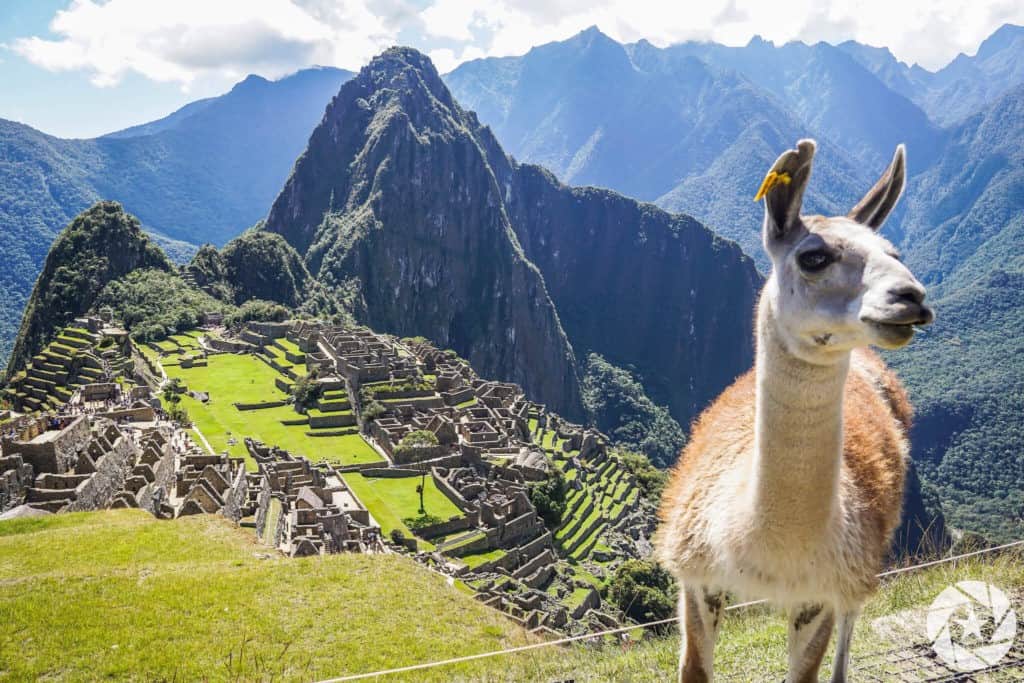
Spot Llamas at the Central Plaza
This is a great opportunity to spot the odd llamas grazing. This large grassy area lays between the residential buildings and the functional buildings. So, once you are there, enjoy it, admire it but be careful not to step on the grass: walking on the grass is not allowed.
Marvel at the Sacred Rock
Historians still are not certain what this sacred rock was used for, but there is one art-related theory that suggests musical and poetry recitals took place right there where you will be standing. Something you will notice is that this fascinating stone takes the shape of Putucusi mountain that you can see behind it.
Discover the Industrial Section
You have seen sacred places, palaces for kings and princesses but what about the average Inca person? Where did they live? Well, it is thought that in this large section of Machu Picchu the everyday Inca citizen practiced their social life.
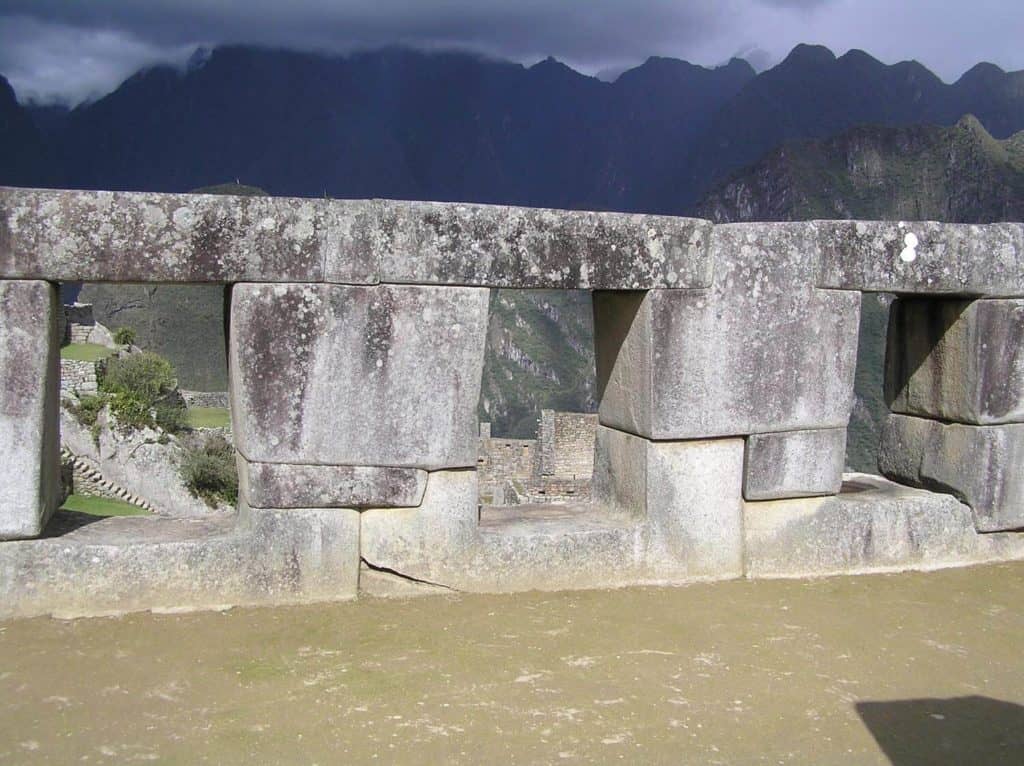
Visit the Prison Group
All societies had prisoners and Incas were no exception. Following their procedures for law and order, they kept their prisoners above and underground and sometimes in deep holes with cell doors.
Find Intimachay – The Cave of the Sun
If you visit Machu Picchu during December for the summer solstice, you will be the lucky one to enjoy a once-in-a-lifetime view of this temple that comes alive with its rear wall radiantly illuminated by the light of the great sun.
Have Lunch at the Tinkuy Restaurant
If you’re in the mood to splurge, this is the place to do it! The Tinkuy restaurant has wonderful food, high-quality service and an amazing location, right at the entrance of Machu Picchu! The unique spot lets you enjoy your meal whilst contemplating the Inca Citadel. It is part of the Belmond Sanctuary Lodge Hotel, a luxurious place to relax, rest and recharge after you see the Machu Picchu ruins.
Enjoy a meal at the Tinkuy Restaurant on our 5-day luxury Inca Trail tour (included in the price). Or, if you trek with us and your tour includes a night’s stay in a hotel in Aguas Calientes, you might consider upgrading your hotel to live the experience at the luxury Sanctuary Lodge Hotel and the Tinkuy Restaurant.
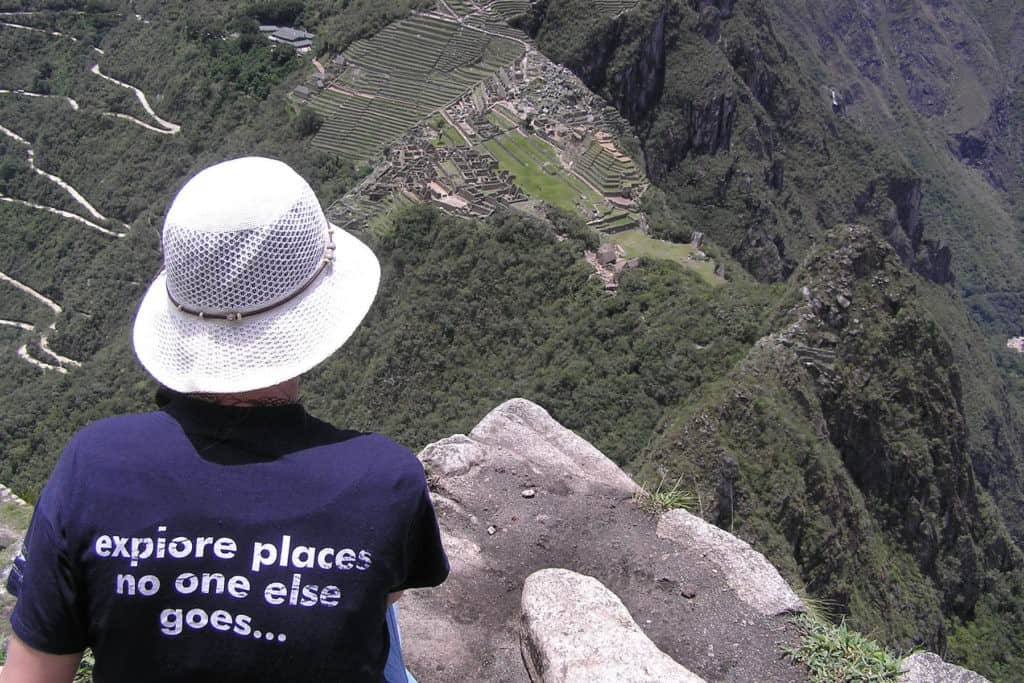
More Things to Do at Machu Picchu: Climb Huayna Picchu & More!
Huayna Picchu
Climb the majestic mountain of Huayna Picchu that sits behind the Machu Picchu ruins and you will see not just the citadel in its fullest, but also the snowcapped peaks of the surrounding Andes.
Huayna Picchu – which means “young peak” in Quechua (machu picchu means “old peak”) – is actually the mountain that you see in those classic shots of Machu Picchu. It’s a challenging climb, and definitely not for the faint of heart! But for those who are up for it, the views make it all worth it. From the peak of the mountain, you can enjoy a wonderful view of the Urubamba River below, and on the north, you will observe the Temple of the Moon, which you can visit by taking an optional detour.
Machu Picchu Mountain
One of the greatest Machu Picchu experiences for avid explorers is climbing “Machu Picchu Montaña” where, during Inca times, locals held different types of ceremonies related to their cosmovision.
Machu Picchu Mountain (also sometimes called Cerro Machu Picchu in Spanish) is the mountain above the citadel, in the direction of Inti Punku, the Sun Gate.
If you couldn’t purchase a ticket for Huayna Picchu or simply don’t like heights, the three hour hike to Machu Picchu Montaña is a great option. This summit is located 601m above the citadel of Machu Picchu (at 3051m in altitude). While hiking this mountain, you will find yourself in a quiet place surrounded by nature with lots of fresh air and a panoramic view of the Incan ruins.
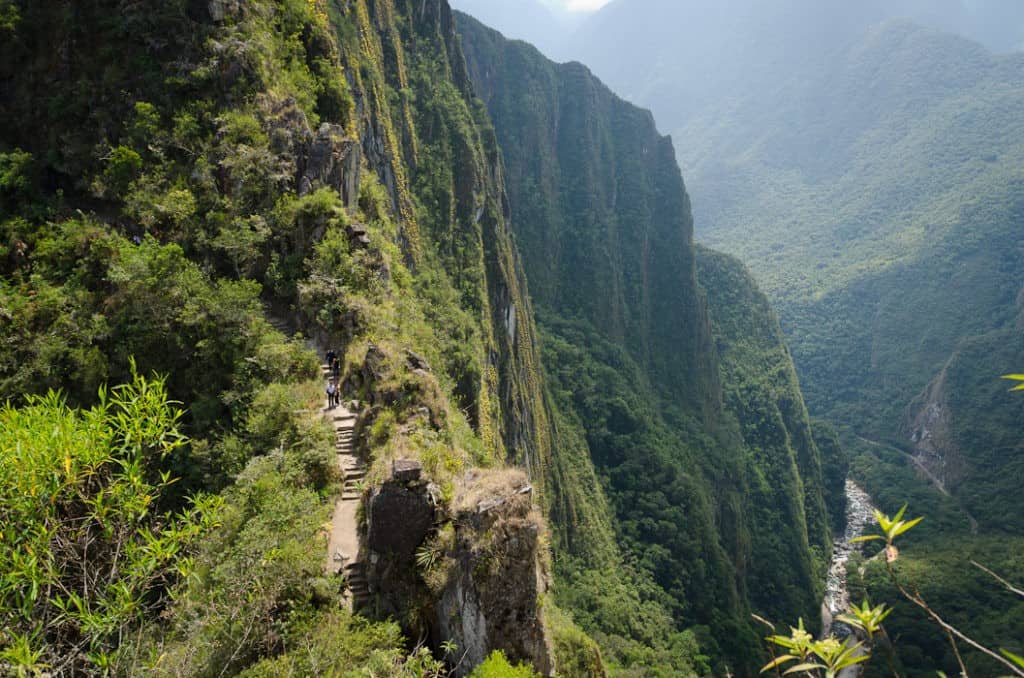
Huchuy Picchu Mountain
Recently, local authorities have opened the hiking trail to the summit of this lower mountain that guards the ruins of the citadel and is located next to the popular Huayna Picchu.
The route takes you to the top of Huchuy Picchu mountain (huchuy picchu means “small peak”) and then back along Circuit 3. Huchuy Picchu is an easy to moderate hike, and it will take you approximately 40 minutes to 1 hour, depending on your physical condition. Its altitude reaches 2497m, just 50m higher than the ruins of Machu Picchu – that’s probably why it’s called the “small” peak!
Visiting Machu Picchu: Things to Do in Aguas Calientes
What can you do in Machu Picchu besides touring the Inca citadel itself, or doing one of the hikes? Actually, a lot! The charming town of Aguas Calientes – also known as Machupicchu Pueblo – that is located at the foot of the mountain welcomes you to explore gorgeous sites such as the hot springs, the gardens of Mandor and local shops to purchase some artifacts from Machu Picchu.
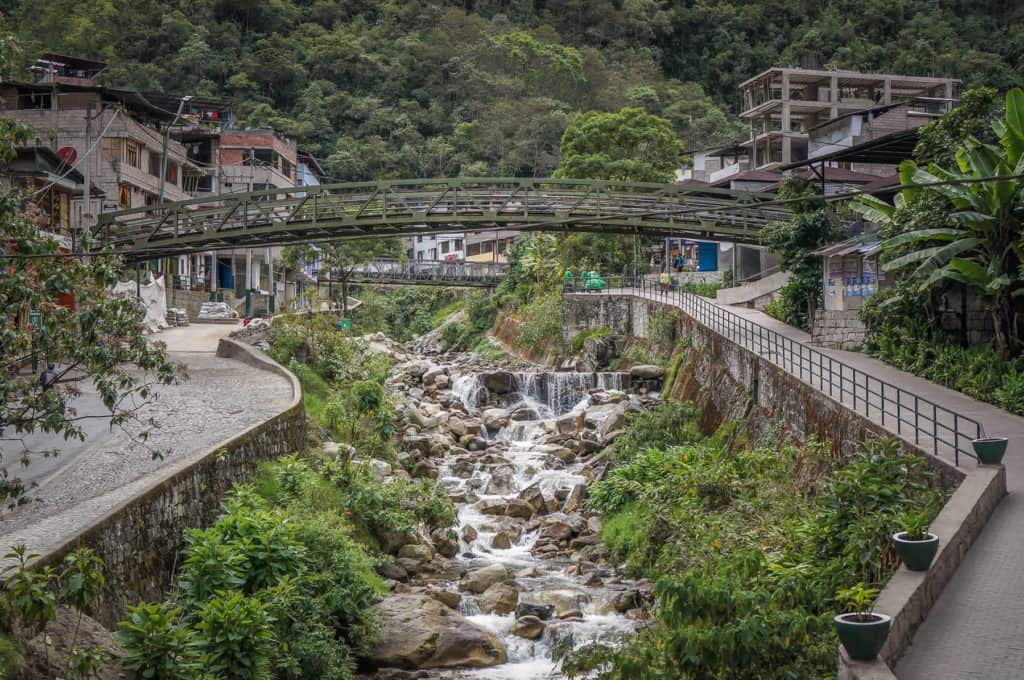
Butterfly Sanctuary
The butterfly house is one of the Machu Picchu tourist attractions that seek out the balance between conservation and sustainable development, promoting research, training and education of the species. Here, visitors will be surrounded by the coloured wings of butterflies that invite you to interact with them and their habitat. People visiting this tourist attraction in Machu Picchu will be accompanied by a specialist who provides valuable information about these wonderful species.
Orchid Garden
In ancient Peru, orchids had great relevance to different cultures, including the Chavín culture and the Incas. Ongoing research has meant greater achievements in terms of knowledge and preservation of orchid diversity in all Machu Picchu areas.
This is one of the things to do in Machu Picchu town. Located on the train tracks on the way to the Mandor Waterfall, the Orchid Garden has been run by the Mendoza Mora family for 15 years. The best time of the year to visit is during the rainy season (December and March) when most of the 400 orchids are in bloom. If your tour does not match this time of the year, no worries! You will still be amazed by the beauty and delicacy of the orchids you see.
We go into more detail about Peruvian orchids in our blog; click the link to find out more!
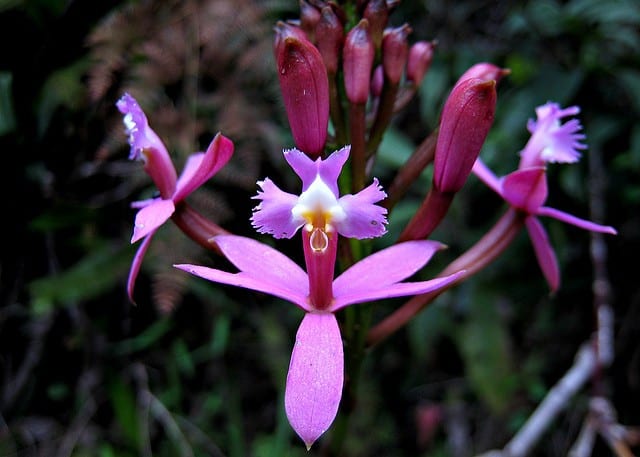
Jardines de Mandor (The Mandor Gardens)
This is a natural habitat that is located at the foot of Huayna Picchu mountain, just 3.5 kilometres from the town of Machu Picchu (Aguas Calientes). Here, travellers can appreciate the most varied native flora and fauna, connect with nature, and enjoy a wonderful landscape with waterfalls.
Hot Springs
These thermal-medicinal waters are easily reached by foot, just 15 minutes’ walk from Aguas Calientes. When travelling to Machu Picchu, give time to visit these medicinal waters and try their healing properties! Due to the chemical composition of the water and its temperature, the hot springs are a good option for those who need some healing for bones, joints and skin, or just want a relaxing post-Inca Trail soak!
Visit the Museum
This museum is very easy to find, just a 30-minute walk from Aguas Calientes. If you visit this site before the Inca citadel, you will be better informed about the place you are about to discover. You will also have a different perspective of what the Inca ruins were like in the past. All artifacts and exhibitions are distributed in seven different sequences full of history and nature.
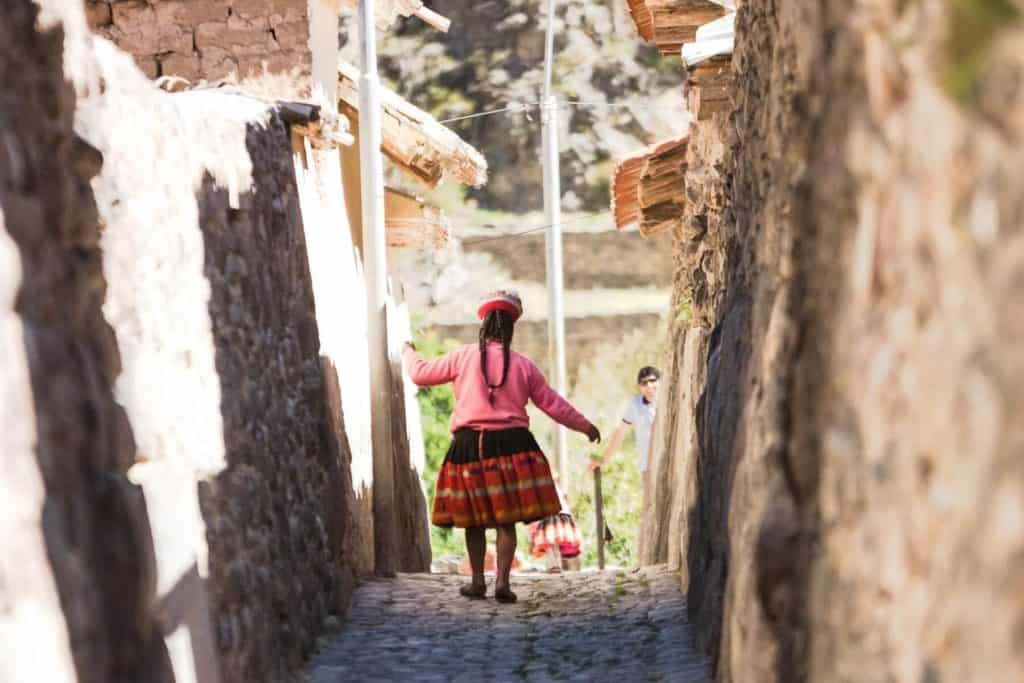
Other Cities Near Machu Picchu to Visit
There are lots of things to do near Machu Picchu. The starting point for any Machu Picchu tour is the multicultural city of Cusco. Plan on spending at least two days exploring Cusco, though we think a three-day itinerary is even better.
No visit to Cusco and Machu Picchu is complete without a tour through the Sacred Valley, too. Some of the main highlights there include the “living Inca city” of Ollantaytambo, Pisac and Urubamba. We tell you how to plan the best tour through the Sacred Valley here.
For a bit of a taste of everything, we’ve put together what we consider the “must-see” tour of Machu Picchu – a 5-day tour that includes the main highlights and, if you’re up for it, a taste of the Inca Trail, too!
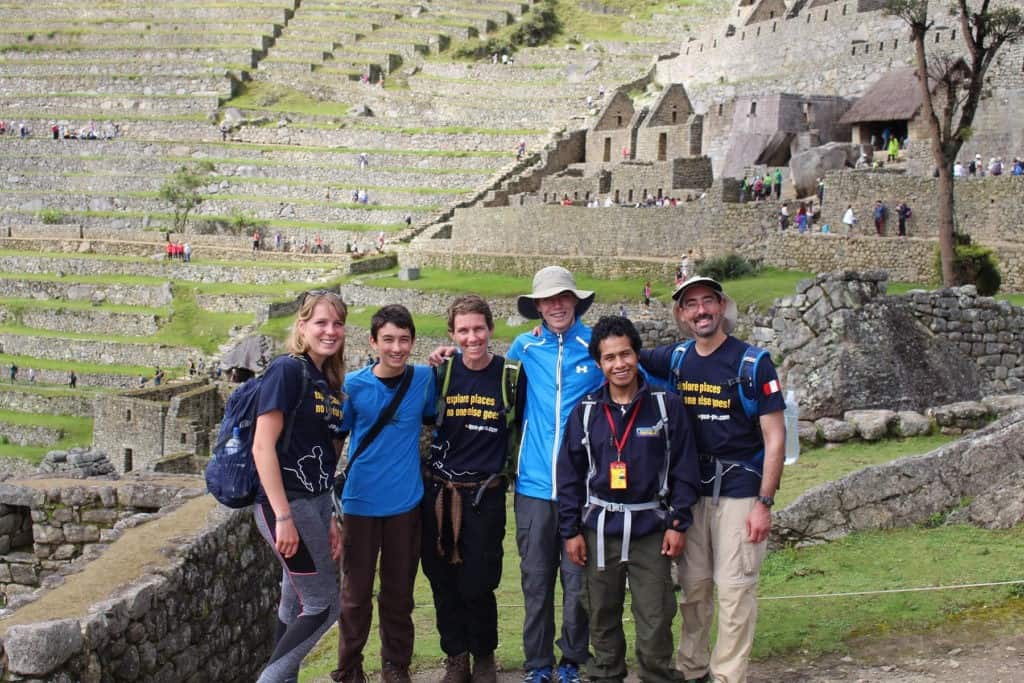
More Resources: How to Plan Your Trip to Machu Picchu in 2024
A majestic experience like this one requires a bit of planning and organization but, trust us, it is well worth it! You are about to visit one of the Seven Wonders of the New World. So, don’t feel overwhelmed with all information, let’s go step by step.
Grab your favourite drink, and take a moment to check out these useful posts we have prepared for you:
- How to Get There – should you hike or take the train? We go through all the options.
- What to wear for Machu Picchu
- Does Machu Picchu Live Up to the Hype? – we go through 7 reasons why we think it does!
- Alternatives to Machu Picchu – maybe you’ve already been, or maybe you’re just not convinced, but if you want to skip Machu Picchu on your trip to Peru, we offer some equally stunning alternative places to visit instead.
- Altitude Acclimatization – you don’t want to fall victim to altitude sickness at Machu Picchu! Follow the advice in our blog and you’ll do just fine.
So Many Things To Do at Machu Picchu!
This world heritage site is the most emblematic cultural and natural area of Peru that attracts travellers from every part of the world. You will be surprised at all the different things to do at Machu Picchu, such as learning about the connection between the Andean cosmic world and its marvellous biodiversity.
In addition, when you explore some of the places to go in Machu Picchu – its constructions, ceremonial centres and aqueducts, just to name a few – you will have a diverse interpretation of what the citadel really is. So, take this trip as a reward of feelings and moments that will leave an unforgettable mark on your life. That is the best way to see Machu Picchu.
Like It? Pin It! 
Sources
Wust, (2010). Machu Picchu. Song of Stone. Walter H. Wust Ediciones SAC
This post was originally published on 3 April, 2017. It was updated on 25 June, 2024.

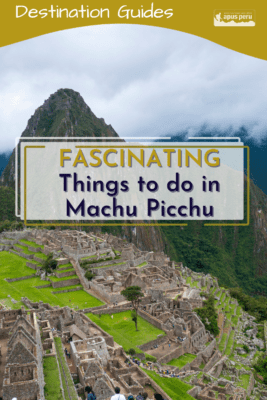
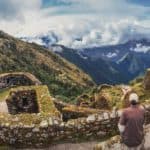
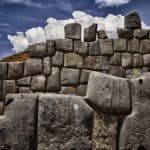
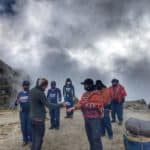
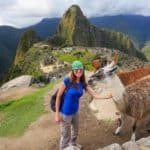
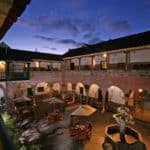


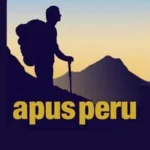

Good post about visiting Machu Picchu. Informative and to the point. I was there last year and LOVED Peru.
Thank You! It is such a beautiful and inspiring place!